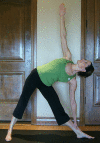Yoga and pilates in the management of low back pain
- PMID: 19468897
- PMCID: PMC2684152
- DOI: 10.1007/s12178-007-9004-1
Yoga and pilates in the management of low back pain
Abstract
Many interventions for the management of low back pain exist, however most have modest efficacy at best, and there are few with clearly demonstrated benefits once pain becomes chronic. Therapeutic exercise, on the other hand, does appear to have significant benefits for managing patients with chronic low back pain (CLBP) in terms of decreasing pain and improving function. In addition, because chronic pain is complex and does not fit a simple model, there have also been numerous trials investigating and demonstrating the efficacy of multidisciplinary pain programs for CLBP. It follows that interventions that treat more than one aspect of LBP would have significant benefits for this patient population. Yoga and Pilates which have, both been gaining in popularity over the last decade are two mind-body exercise interventions that address both the physical and mental aspects of pain with core strengthening, flexibility, and relaxation. There has been a slow evolution of these nontraditional exercise regimens into treatment paradigms for LBP, although few studies examining their effects have been published. The following article will focus on the scientific and theoretical basis of using yoga and Pilates in the management of CLBP.
Figures
Similar articles
-
The definition and application of Pilates exercise to treat people with chronic low back pain: a Delphi survey of Australian physical therapists.Phys Ther. 2014 Jun;94(6):792-805. doi: 10.2522/ptj.20130030. Epub 2013 Oct 31. Phys Ther. 2014. PMID: 24179139
-
Effects of Pilates and trunk strengthening exercises on health-related quality of life in women with chronic low back pain.J Back Musculoskelet Rehabil. 2016 Nov 21;29(4):649-659. doi: 10.3233/BMR-160665. J Back Musculoskelet Rehabil. 2016. PMID: 26922845 Clinical Trial.
-
Short- and long-term effects of a six-week clinical Pilates program in addition to physical therapy on postmenopausal women with chronic low back pain: a randomized controlled trial.Disabil Rehabil. 2016;38(13):1300-8. doi: 10.3109/09638288.2015.1090485. Epub 2015 Oct 16. Disabil Rehabil. 2016. PMID: 26474232 Clinical Trial.
-
Yoga compared to non-exercise or physical therapy exercise on pain, disability, and quality of life for patients with chronic low back pain: A systematic review and meta-analysis of randomized controlled trials.PLoS One. 2020 Sep 1;15(9):e0238544. doi: 10.1371/journal.pone.0238544. eCollection 2020. PLoS One. 2020. PMID: 32870936 Free PMC article.
-
Exercise Benefits for Chronic Low Back Pain in Overweight and Obese Individuals.PM R. 2017 Feb;9(2):181-192. doi: 10.1016/j.pmrj.2016.06.019. Epub 2016 Jun 23. PM R. 2017. PMID: 27346092 Review.
Cited by
-
Psychological effects of calisthenic exercises on neuroinflammatory and rheumatic diseases.Z Rheumatol. 2015 Oct;74(8):722-7. doi: 10.1007/s00393-015-1570-9. Z Rheumatol. 2015. PMID: 26115762 Clinical Trial.
-
Development and validation of a pre-scoring system for nonspecific low back pain among general population in Guangzhou: a cross-sectional study.BMC Public Health. 2019 Sep 12;19(1):1262. doi: 10.1186/s12889-019-7564-9. BMC Public Health. 2019. PMID: 31510992 Free PMC article.
-
Effects of Pilates Training on Cardiorespiratory Functions in Medical Conditions - Comprehensive Approach: A Narrative Review.Aging Dis. 2024 Aug 1;15(4):1771-1783. doi: 10.14336/AD.2023.0929. Aging Dis. 2024. PMID: 38029402 Free PMC article. Review.
-
Mind-Body Therapies and Osteoarthritis of the Knee.Curr Rheumatol Rev. 2009 Nov 1;5(4):204-211. doi: 10.2174/157339709790192512. Curr Rheumatol Rev. 2009. PMID: 21151770 Free PMC article.
-
Effects of Pilates exercise programs in people with chronic low back pain: a systematic review.Medicine (Baltimore). 2015 Jan;94(4):e383. doi: 10.1097/MD.0000000000000383. Medicine (Baltimore). 2015. PMID: 25634166 Free PMC article.
References
-
- Saper RB, Eiseberg DM, Davis RB, Culpepper L, Phillips RS. Prevalence and patterns of adult yoga use in the United States: results of a national survey. Altern Ther Health Med. 2004;10:44–9. - PubMed
-
- Jacobs BP, Mehling W, Goldberg HA, Eppel E, Acree M, Lasater JH, et al. Feasibility of conducting a clinical trial on Hatha yoga for chronic low back pain: methodological lessons. Altern Ther Health Med. 2004;10:80–3. - PubMed
-
- Galantino ML, Bzdewka TM, Eissler-Russo JL, Holbrook ML, Mogck EP, Geigle P, et al. The impact of modified Hatha yoga on chronic low back pain: a pilot study. Altern Ther Health Med. 2004;10:56–9. - PubMed
-
- Williams K, Steinberg L, Petronis J. Therapeutic application of Iyengar yoga for healing chronic low back pain. Int J Yoga Ther. 2003;13:55–67.
LinkOut - more resources
Full Text Sources
Medical
Miscellaneous





